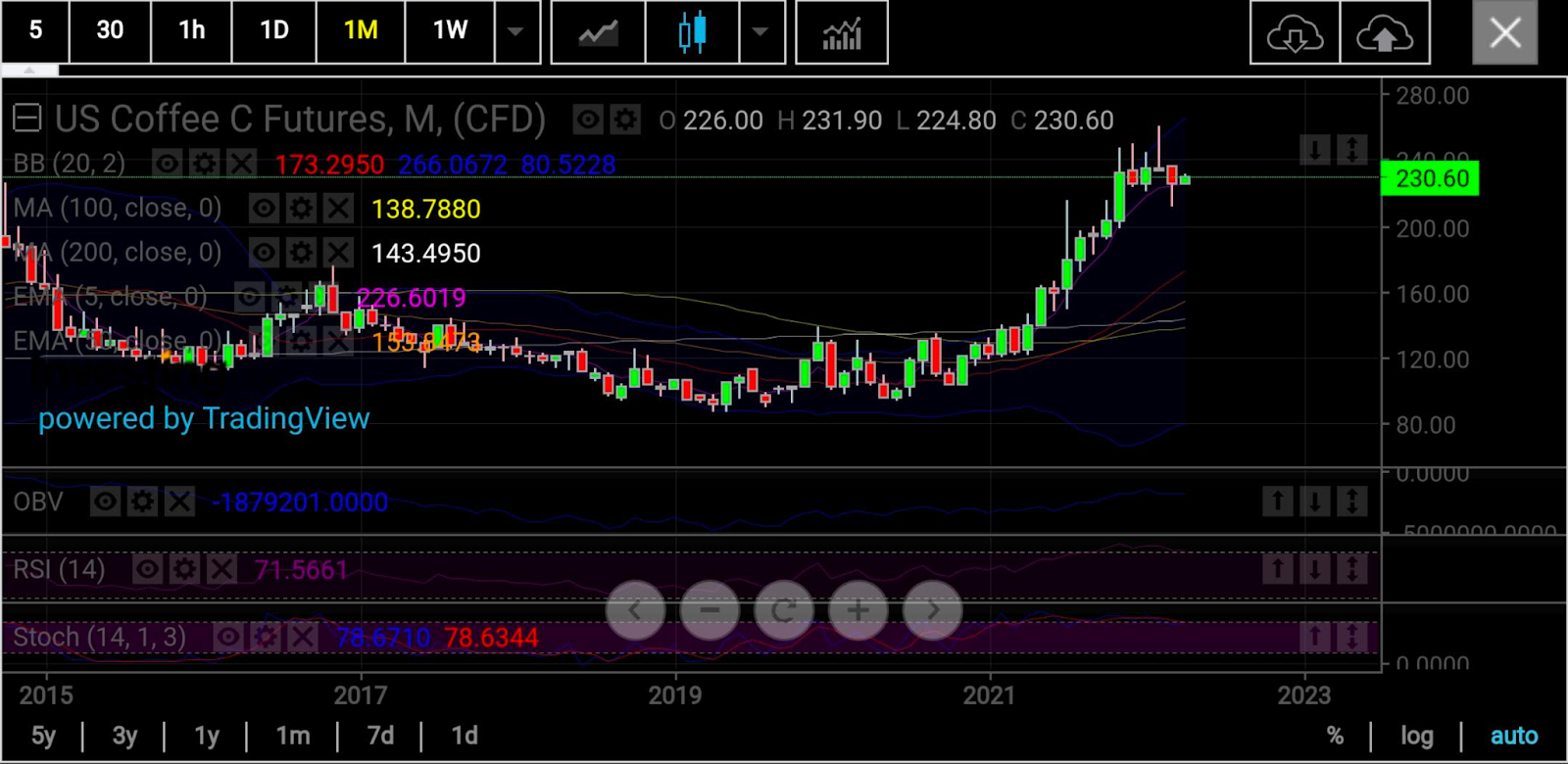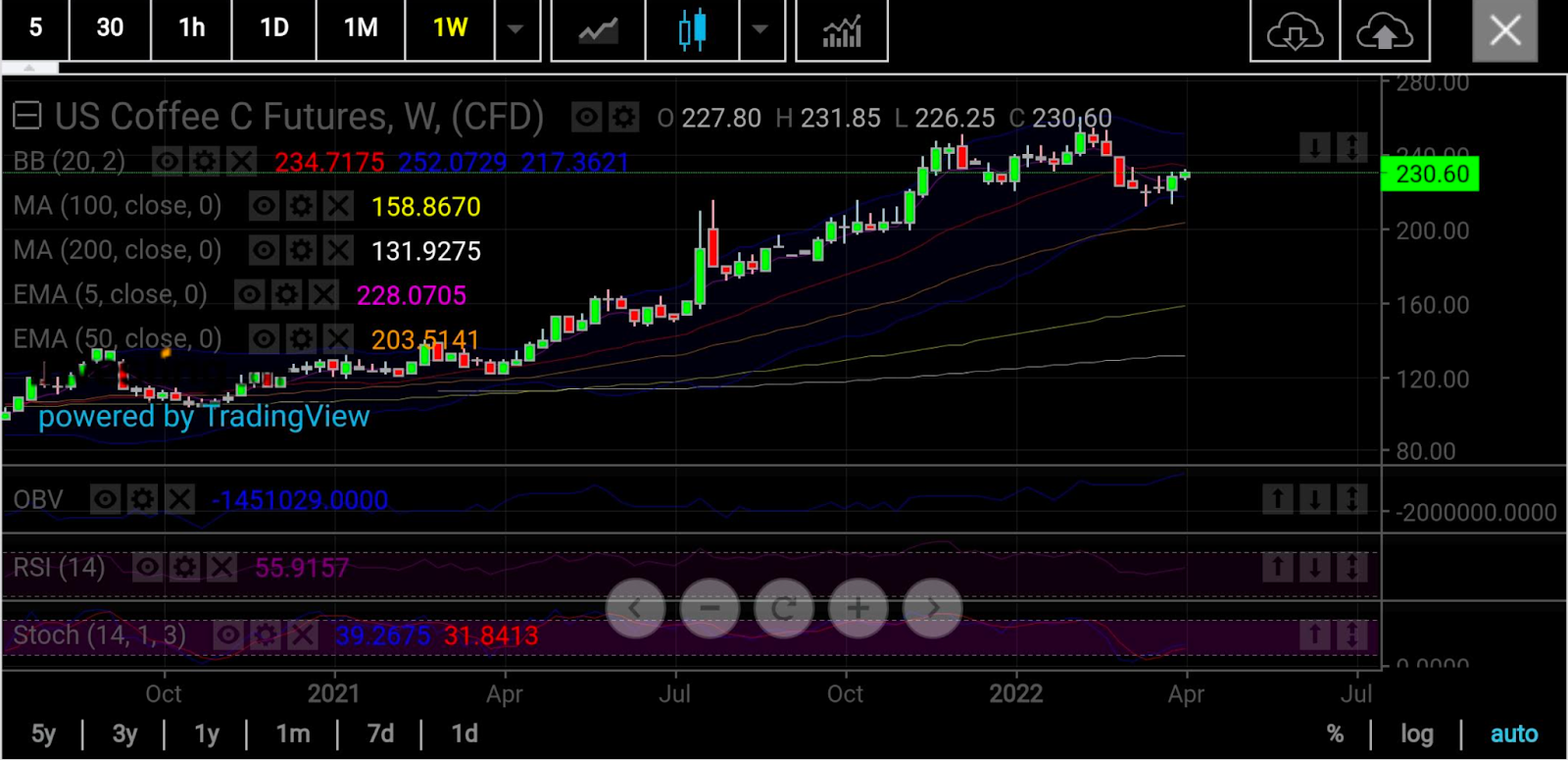One of last year’s hottest commodities is doing just so-so this year. Arabica, the premium coffee bean, whose prices were steaming for most of 2021, is barely in rally mode now. Meanwhile, robusta, the lower-end coffee bean which actually outperformed arabica last year, is down double-digits.
A lack of demand across Europe in the aftermath of the Russia-Ukraine war appears to be the primary blame cited by analysts, although arabica’s performance itself might change soon with its unbroken winning streak over the past week.
In Monday’s trade, arabica’s front-month contract on ICE Futures US settled at around $2.31 per lb. That gave it a gain of just 2.2% on the year, compared with 76% in 2021.
But improving trading signals since Mar. 29 suggest that arabica could reach $2.45 in the near term, giving it a gain of more than 8% on the year that nears the 10-year highs of $2.60 hit in February.
“The daily chart has been showing consistent retracement from arabica’s low of $2.12 made on Mar. 28,” said Sunil Kumar Dixit, chief technical strategist at skcharting.com.

All charts courtesy of skcharting.com
Consumed by more than two-thirds of the coffee-drinking world, arabica ranks as the bean of choice for renowned coffee chains from Starbucks (NASDAQ:SBUX) to Restaurant Brands (NYSE:QSR) owned Tim Hortons and Dunkin' Donuts. Last year’s run-up in its price was due to production outages in COVID-hit farms and processing centers, as well as shipping constraints that made it hard to get the bean out in time from major grower Brazil.
This year, arabica started strongly, with a 4% gain in January.
But as tremors from the Russia-Ukraine conflict worsened in early February, arabica’s momentum began to fade amid fears there might be less consumption in Europe—the world’s largest coffee market, which accounts for 33% of global demand.
While arabica remained on good footing to hit 10-year highs in early February, the invasion of Ukraine ordered by Vladimir Putin on Feb. 24 and the events over the next month affirmed the coffee trade’s concerns, wiping out its 4% gain from January over the next two months.
Surprisingly, arabica managed to end the first quarter flat, with a March closing price that virtually matched December’s $2.26.

Dixit of skcharting cautioned that the coffee bean could be in peril again if it begins consolidating at below $2.24—a move that could lead to a potential retest of the $2.12 low and further acceleration downward to $2.05 - $1.95.
But to offset that, the last five sessions have been a boon, he said.
“The 200-Day Simple Moving Average of $2.09 seems to have provided short term support to arabica,” Dixit said, adding:
“So long as it holds at above the $2.24 - $2.28 dynamic support area, the move up can continue to $2.35 - $2.40 -$2.45 over short-to-mid term.”

Fundamentals seem to be turning as well in arabica’s favor.
On the negative side, the war was causing less demand in Europe, and this was compounded by the new COVID outbreak in Shanghai, China that had “the potential to really hurt Chinese demand as cities and ports have shut down there,” according to Jack Scoville, chief crop analyst at Chicago commodities broker Price Futures Group.
But to balance this, said Scoville, “the lack of deliveries from Brazil and Indonesia are still supporting the futures market” for arabica.
He added:
“Good growing conditions for the next crop in Brazil are still around, but flowering is reported to be uneven this year in at least some areas.”
On the robusta side as well, he said fewer deliveries were reported from major grower Vietnam “as producers have sold most of the crop and are holding the rest and waiting for higher prices.”
Robusta is used in most instant coffee brands in the market and is a natural choice for decaffeinated coffee. Also grown to some extent in Indonesia, Africa and India, robusta has the same supply and crop issues as arabica, but without commensurate demand.
In Monday’s trade on ICE Futures Europe, robusta settled at $2,136 a tonne, down 14% on the year, contrasting with its 2021 rally of 81%.
Despite coffee’s improving market prices and crop fundamentals, some analysts fear that runaway global inflation fed by oil prices trading at near 14-year highs of above $100 per barrel would be detrimental to coffee retailers as consumers cut back on costs.
“It’s going to get more painful with surging energy costs,” Thomas Hartley, president and owner of Hartley Transportation, said in a Bloomberg story last month that cited fuel-expense surge, elevated transportation costs, lack of shipping containers, shortage of truck drivers and other workers and other logistics snags as problems facing the industry.
While supply-chain woes have spared few industries globally, coffee and some other crops have been hit especially hard. That’s because surging transportation expenses are compounding the impact on prices of a slump in crop production in Brazil, the world’s biggest exporter of coffee, sugar and soybeans.
Janet Colley Morse, vice president of Dupuy Group, a warehousing firm, says her company is having trouble hiring loaders and administrative personnel, and challenges can vary from port to port. A dearth of trucks to get into the ports to pick up containers has resulted in up to four-week delays, which backs up the entire supply chain, John DeMuria, a trader with Volcafe, said during a question-and-answer session at a coffee event.
But in another positive sign, top coffee exporter Brazil has seen record demand for bookings, said Luca Scamardella, import trade manager at Mediterranean Shipping Company.
Companies were trying to modify capacity and adjust schedules, and some business has been diverted from especially congested ports such as Long Beach in California to less backed up sites in other cities, he said, adding:
“Our vendors are extremely challenged with extra demand since the summer 2020, a turning point from the pandemic low.”
The other silver lining for the industry is that the specialty coffee trade has been surprisingly resilient.
Specialty coffee is a term for the highest grade of coffee available, typically relating to the entire supply chain, using single origin or single estate coffee. The term was first used in 1974 by Erna Knutsen in an issue of Tea & Coffee Trade Journal. They refer to coffee graded 80 points or above on a 100 point scale by a certified coffee taster or licensed quality grader. They are also said to be grown at the perfect altitude, correct time of year, on the best soil, and picked at the right time.
Onyx, Bean Box, Klatch, Stumptown, Hair Bender and Kona Hawaiian are some brands of specialty coffee.
According to the recent Specialty Coffee Transaction Guide, the price of specialty coffee has risen reliably year over year, due in part to specialty coffee’s commitment to building long-term relationships with farmers and buying practices untethered to the whims of the commodity market.
While the spike in oil prices will surely increase shipping costs across the board, the specialty sector of the coffee industry appears poised to withstand short-term volatility stemming from the changing oil prices—at least for now.
Disclaimer: Barani Krishnan uses a range of views outside his own to bring diversity to his analysis of any market. For neutrality, he sometimes presents contrarian views and market variables. He does not hold positions in the commodities and securities he writes about.
Which stock should you buy in your very next trade?
AI computing powers are changing the stock market. Investing.com's ProPicks AI includes 6 winning stock portfolios chosen by our advanced AI. In 2024 alone, ProPicks AI identified 2 stocks that surged over 150%, 4 additional stocks that leaped over 30%, and 3 more that climbed over 25%. Which stock will be the next to soar?
Unlock ProPicks AI